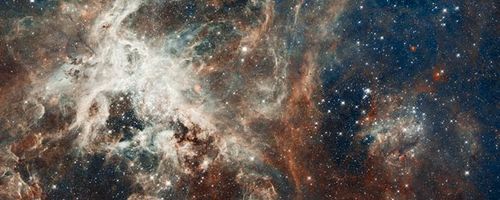NASA/Hubble explains a new image whose magnitude is nearly impossible to fathom:
30 Doradus is the brightest star-forming region in our galactic neighbourhood and home to the most massive stars ever seen. The nebula resides 170 000 light-years away in the Large Magellanic Cloud, a small, satellite galaxy of our Milky Way. No known star-forming region in our galaxy is as large or as prolific as 30 Doradus.
The image comprises one of the largest mosaics ever assembled from Hubble photos and consists of observations taken by Hubble's Wide Field Camera 3 and Advanced Camera for Surveys, combined with observations from the European Southern Observatory's MPG/ESO 2.2-metre telescope that trace the location of glowing hydrogen and oxygen.
The image is being released to celebrate Hubble's 22nd anniversary.
The stars in this image add up to a total mass millions of times bigger than that of our Sun. The image is roughly 650 light-years across and contains some rambunctious stars, from one of the fastest rotating stars to the speediest and most massive runaway star.
A larger, more expandable version is available at Hubble's site.




